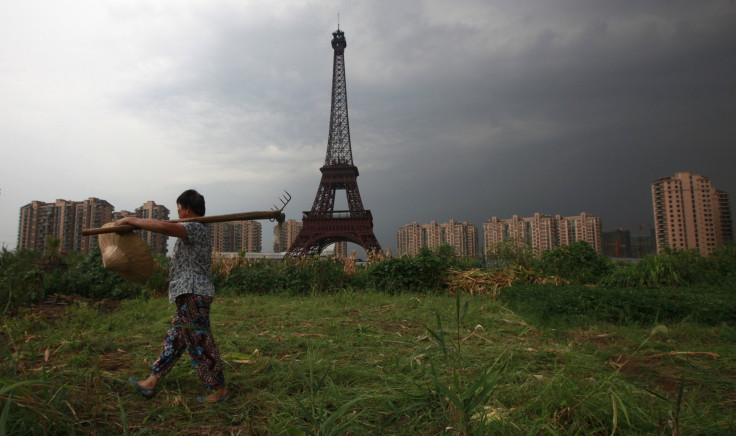China's Luxurious, Newly Built 'Ghost' Cities: Oh-So Extravagant And Oh-So Empty

With migrant workers in China living in makeshift shacks and native college graduates needing affordable apartments, you wouldn’t think China could afford to have large swaths of unoccupied land. Yet that’s exactly what happened with Jing Jin City, a satellite city an hour outside Beijing that is home to 3,000 villas, most of them not lived in -- and this is only one of several such developments around the country.
Jing Jin City is situated off of Jingjin Highway, which connects Beijing to the city of Tianjing. The development covers more than 54 square kilometers (13,096 acres) and boasts a five-star hotel, hot springs, a golf course, a museum, a temple, two colleges and entertainment facilities in addition to the villas, the South China Morning Post said Monday. Luxurious surroundings -- but they're not surrounding anyone.
A representative for Hopson Development, the Hong Kong-listed developer that built the project along with Tianjin’s Baodi district government, said the community is a work in progress and the occupancy rate is climbing. But experts say that in these new cities, infrastructure and economic opportunities lag the pace of property development, making it difficult to attract residents.
Yang Kang, a salesman at the development sales center, said most of the villas have been sold, but many of the owners are wealthy executives or government officials who rarely have time to visit. Most owners bought their home as an investment, for retirement or for holiday use.
The main street in Jing Jin City is mostly empty. Some businesses venture in but soon close when the owners realize there's no decent consumer base. The reverse is also true: With so few amenities, and a long commute to both Beijing and Tianjin, it is not practical for working professionals to live here.
“It only suits those who have retired but are not too old,” said Zhao Zongsheng, who operates an unregistered taxi service outside the colleges in Jing Jin City, according to the South China Morning Post.
Half of the project’s land has yet to be developed, and plans for 4,000 additional villas are in the works. The company also plans to establish a street dedicated to bringing in new businesses, and is in talks with international brands like KFC, which is owned by YUM! Brands Inc. (NYSE:YUM) and McDonald’s Corporation (NYSE:MCD).
Hopson remains optimistic for the future of the development and believes the project just needs a bit more time.
“We are not just building houses, but a city instead. It’s not that we can create a city within 10 years,” said Zhao Yuting, Hopson’s regional general manager for Tianjin, speaking to the company's ambition to build a brand new city, rather than just a property development. The company has plans for more facilities as well, including the Tianjin Municipal Hospital of Traditional Chinese Medicine, according to the South China Morning Post.
Jing Jin City is by no means the only up-scale ghost town in China. A survey of 12 provinces and autonomous regions by the National Development and Reform Commission (NDRC) found that each city-level government had erected one such project, the People’s Daily reported last month. But again, with no established industries in these developments, occupancy rates have languished.
"In many new cities, the homes have been sold but lie idle," said Qiao Runling, deputy director of the NDRC’s China Center for Urban Development, pointing out that these projects not only occupy large tracts of farmland but also constitute high financial risks for local governments, reported the South China Morning Post. "It's totally different from what we imagine a real city should be."
© Copyright IBTimes 2024. All rights reserved.




















